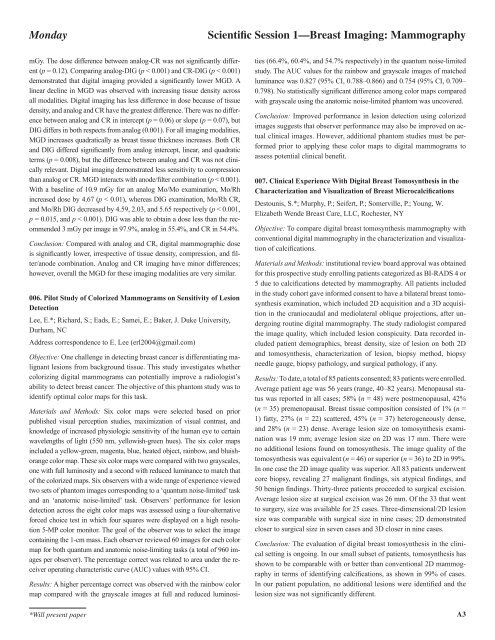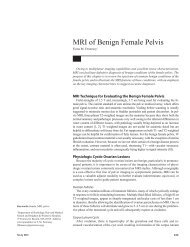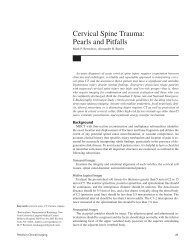Scientific Session 1 â Breast Imaging: Mammography
Scientific Session 1 â Breast Imaging: Mammography
Scientific Session 1 â Breast Imaging: Mammography
You also want an ePaper? Increase the reach of your titles
YUMPU automatically turns print PDFs into web optimized ePapers that Google loves.
Monday<strong>Scientific</strong> <strong>Session</strong> 1—<strong>Breast</strong> <strong>Imaging</strong>: <strong>Mammography</strong>mGy. The dose difference between analog-CR was not significantly different(p = 0.12). Comparing analog-DIG (p < 0.001) and CR-DIG (p < 0.001)demonstrated that digital imaging provided a significantly lower MGD. Alinear decline in MGD was observed with increasing tissue density acrossall modalities. Digital imaging has less difference in dose because of tissuedensity, and analog and CR have the greatest difference. There was no differencebetween analog and CR in intercept (p = 0.06) or slope (p = 0.07), butDIG differs in both respects from analog (0.001). For all imaging modalities,MGD increases quadratically as breast tissue thickness increases. Both CRand DIG differed significantly from analog intercept, linear, and quadraticterms (p = 0.008), but the difference between analog and CR was not clinicallyrelevant. Digital imaging demonstrated less sensitivity to compressionthan analog or CR. MGD interacts with anode/filter combination (p < 0.001).With a baseline of 10.9 mGy for an analog Mo/Mo examination, Mo/Rhincreased dose by 4.67 (p < 0.01), whereas DIG examination, Mo/Rh CR,and Mo/Rh DIG decreased by 4.59, 2.03, and 5.65 respectively (p < 0.001,p = 0.015, and p < 0.001). DIG was able to obtain a dose less than the recommended3 mGy per image in 97.9%, analog in 55.4%, and CR in 54.4%.Conclusion: Compared with analog and CR, digital mammographic doseis significantly lower, irrespective of tissue density, compression, and filter/anodecombination. Analog and CR imaging have minor differences;however, overall the MGD for these imaging modalities are very similar.006. Pilot Study of Colorized Mammograms on Sensitivity of LesionDetectionLee, E.*; Richard, S.; Eads, E.; Samei, E.; Baker, J. Duke University,Durham, NCAddress correspondence to E. Lee (erl2004@gmail.com)Objective: One challenge in detecting breast cancer is differentiating malignantlesions from background tissue. This study investigates whethercolorizing digital mammograms can potentially improve a radiologist’sability to detect breast cancer. The objective of this phantom study was toidentify optimal color maps for this task.Materials and Methods: Six color maps were selected based on priorpublished visual perception studies, maximization of visual contrast, andknowledge of increased physiologic sensitivity of the human eye to certainwavelengths of light (550 nm, yellowish-green hues). The six color mapsincluded a yellow-green, magenta, blue, heated object, rainbow, and bluishorangecolor map. These six color maps were compared with two grayscales,one with full luminosity and a second with reduced luminance to match thatof the colorized maps. Six observers with a wide range of experience viewedtwo sets of phantom images corresponding to a ‘quantum noise-limited’ taskand an ‘anatomic noise-limited’ task. Observers’ performance for lesiondetection across the eight color maps was assessed using a four-alternativeforced choice test in which four squares were displayed on a high resolution5-MP color monitor. The goal of the observer was to select the imagecontaining the 1-cm mass. Each observer reviewed 60 images for each colormap for both quantum and anatomic noise-limiting tasks (a total of 960 imagesper observer). The percentage correct was related to area under the receiveroperating characteristic curve (AUC) values with 95% CI.*Will present paperResults: A higher percentage correct was observed with the rainbow colormap compared with the grayscale images at full and reduced luminosities(66.4%, 60.4%, and 54.7% respectively) in the quantum noise-limitedstudy. The AUC values for the rainbow and grayscale images of matchedluminance was 0.827 (95% CI, 0.788–0.866) and 0.754 (95% CI, 0.709–0.798). No statistically significant difference among color maps comparedwith grayscale using the anatomic noise-limited phantom was uncovered.Conclusion: Improved performance in lesion detection using colorizedimages suggests that observer performance may also be improved on actualclinical images. However, additional phantom studies must be performedprior to applying these color maps to digital mammograms toassess potential clinical benefit.007. Clinical Experience With Digital <strong>Breast</strong> Tomosynthesis in theCharacterization and Visualization of <strong>Breast</strong> MicrocalcificationsDestounis, S.*; Murphy, P.; Seifert, P.; Somerville, P.; Young, W.Elizabeth Wende <strong>Breast</strong> Care, LLC, Rochester, NYObjective: To compare digital breast tomosynthesis mammography withconventional digital mammography in the characterization and visualizationof calcifications.Materials and Methods: institutional review board approval was obtainedfor this prospective study enrolling patients categorized as BI-RADS 4 or5 due to calcifications detected by mammography. All patients includedin the study cohort gave informed consent to have a bilateral breast tomosynthesisexamination, which included 2D acquisition and a 3D acquisitionin the craniocaudal and mediolateral oblique projections, after undergoingroutine digital mammography. The study radiologist comparedthe image quality, which included lesion conspicuity. Data recorded includedpatient demographics, breast density, size of lesion on both 2Dand tomosynthesis, characterization of lesion, biopsy method, biopsyneedle gauge, biopsy pathology, and surgical pathology, if any.Results: To date, a total of 85 patients consented; 83 patients were enrolled.Average patient age was 56 years (range, 40–82 years). Menopausal statuswas reported in all cases; 58% (n = 48) were postmenopausal, 42%(n = 35) premenopausal. <strong>Breast</strong> tissue composition consisted of 1% (n =1) fatty, 27% (n = 22) scattered, 45% (n = 37) heterogeneously dense,and 28% (n = 23) dense. Average lesion size on tomosynthesis examinationwas 19 mm; average lesion size on 2D was 17 mm. There wereno additional lesions found on tomosynthesis. The image quality of thetomosynthesis was equivalent (n = 46) or superior (n = 36) to 2D in 99%.In one case the 2D image quality was superior. All 83 patients underwentcore biopsy, revealing 27 malignant findings, six atypical findings, and50 benign findings. Thirty-three patients proceeded to surgical excision.Average lesion size at surgical excision was 26 mm. Of the 33 that wentto surgery, size was available for 25 cases. Three-dimensional/2D lesionsize was comparable with surgical size in nine cases; 2D demonstratedcloser to surgical size in seven cases and 3D closer in nine cases.Conclusion: The evaluation of digital breast tomosynthesis in the clinicalsetting is ongoing. In our small subset of patients, tomosynthesis hasshown to be comparable with or better than conventional 2D mammographyin terms of identifying calcifications, as shown in 99% of cases.In our patient population, no additional lesions were identified and thelesion size was not significantly different.A3
















